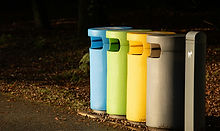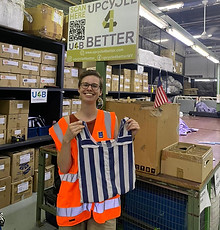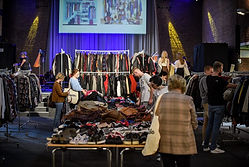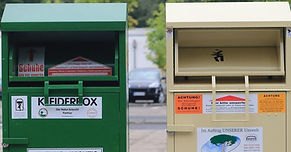Germany
- Written by Isabell
Which kind of waste bins do you have in your household?

A yellow bin for plastic, a blue bin for paper, a green bin for glass waste and a black/grey bin for general rubbish.
Recycling bin by pavement (Image: Pexels / Simão Moreira)

What would you say is the general attitude toward secondhand clothing in your country?
Secondhand fashion is seen as trendy, especially among the younger generation. In some vintage or secondhand shops, where the selection is carefully curated, prices can be almost as high as new clothing. In contrast, older generations often associate secondhand clothing with poverty or necessity, making it more of a social taboo.
A common concern across all age groups is the perception that used clothing may be unhygienic, which can deter people from buying secondhand items.
Where do people usually buy or sell secondhand clothes?
In Germany, secondhand clothing is accessible through various channels, including online platforms like Vinted, Kleinanzeigen, and Momox Fashion. Additionally, clothes can be found in secondhand shops, clothing swap events and flea markets held throughout the country.

Berlin flea market scene. (Image: Travelers & Dreamers).
How many pieces of clothes does the average person in Germany own?
On average, each person in Germany owns around 159 pieces of clothing, excluding socks and underwear (Maldini et al., Wardrobe study, 2017).
What is one thing that your country could learn from Malaysia/ U4B?
What I appreciate about Upcycle4Better is its holistic approach. The organisation not only collects textile waste and resells it, but also actively engages in upcycling, educational outreach, and community empowerment. I admire their commitment to involving the wider public, supporting single mothers, and providing added value to schoolchildren through meaningful programmes.
Which facts shocked you during your research?
On average, each European buys 26 kg of textiles per year, yet throws away around 11 kg annually.
We wear only about 60% of the clothing in our wardrobe
At Vinokilo, vintage fashion is sold by the kilo, as seen here in Essen. During Black Friday Week 2023, the international event stops in Düsseldorf. (Image: IMAGO / Funke Foto Services).

What are some national campaigns or organizations in your country promoting textile recycling or reuse?
In Germany, there are several notable initiatives promoting textile reuse and sustainability.
For example FairWertung is a nationwide network of non-profit organizations that collect used textiles, offer donation bins, and run educational programs on sustainable consumption.
Deutsche Kleiderstiftung collects clothing for reuse and charity, runs secondhand stores, and ships clothing to people in need, while also promoting sustainable practices through educational projects.
Repair Café where community meeting places to mend, fix, and reuse everyday items. (Image: Design for Sustainability Signals)

Another nice initiative is Repair Cafés which are community spaces where people can bring broken or damaged clothing and receive materials, tools, and support to repair them—encouraging a culture of reuse and waste reduction.
What kind of textile waste recycling points exist in Germany?
Collection points for used clothing are provided by organizations such as Caritas and the German Red Cross (DRK). Caritas is a large Catholic charity organisation in Germany, offering social services and aid to those in need. DRK (Deutsches Rotes Kreuz) is the German branch of the International Red Cross, providing humanitarian assistance, emergency aid and community services.
Containers from reputable providers are marked with a quality seal (Gütesiegel). The DRK offers an online location finder for its clothing donation containers: https://www.drk.de/hilfe-in-deutschland/existenzsichernde-hilfe/kleidercontainer/
You can also find collection points near you via this platform: https://altkleiderspenden.de/
Recycling station constructed entirely from textile waste. (Image: Instagram / @upparelofficial).
However, the volume of donated clothing far exceeds demand on the secondhand market. As a result, a significant portion is exported, particularly to Eastern Europe and various African countries. Unfortunately, 30–40% of these clothes are often unsuitable for the local climate or market conditions and end up in landfills in those countries.
To ensure meaningful reuse, it is recommended to donate wearable items directly to other social welfare organisations.
.jpeg)
How much textile waste is generated in Germany? How much ends up in landfills, how much is recycled?
In 2022, Germany generated approximately 1 million tonnes of textile waste, equivalent to around 12 kg per person per year. While Germany has strict regulations limiting landfill use, a small share (estimated at around 10–12%) of textile waste still ends up in landfills, with a further 14–15% incinerated. Only about 25–30% of the collected textiles are materially recycled, while a significant portion is exported or reused, either domestically or abroad.
References
(n.d.). Research Gate. https://www.researchgate.net/figure/Average-number-of-garments-in-German-wardrobes-according-to-sampling-variables_tbl4_319902973
(n.d.). Altkleider entsorgen: Container oder Restmüll? Diese Regeln gelten [Review of Altkleider entsorgen: Container oder Restmüll? Diese Regeln gelten]. Ndr. https://www.ndr.de/ratgeber/verbraucher/Altkleider-entsorgen-Container-oder-Restmuell-Diese-Regeln-gelten-,altkleider258.html
Schumacher, B. (2019, June 16). Nachhaltige Mode: 10 Tipps für einen nachhaltigen Kleiderschrank. Oekotest.de. https://www.oekotest.de/kosmetik-wellness/Nachhaltige-Mode-10-Tipps-fuer-einen-nachhaltigen-Kleiderschrank_10701_1.html
Clothing and textiles. (2025, May 14). Kreislaufwirtschaft-Deutschland.de. https://www.kreislaufwirtschaft-deutschland.de/en/the-national-circular-economy-strategy-nces/action-areas/clothing-and-textiles
GERMANY. (n.d.). Gemeinschaft Für Textile Zukunft. https://textile-zukunft.de/germany/
5.5 kilograms per capita: 462,500 tonnes of old clothes and second-hand textiles were exported from Germany in 2022. (n.d.). Federal Statistical Office. https://www.destatis.de/EN/Press/2023/03/PE23_N019_51_32.html
I'm a paragraph. Click here to add your own text and edit me

